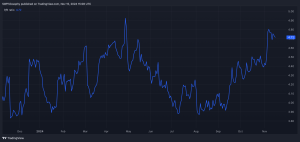Traders are growing increasingly confident that U.S. stocks are headed for a selloff. But history shows the opposite is more likely, according to an analysis by one macro strategist.
Speculative traders are more bearish than at any time in the last decade, according to the latest release from the Commodity Futures Trading Commmission’s weekly commitment of traders report, which tracks futures-market positioning in a number of currencies, commodities and U.S. equity indexes.
Net-short bets by noncommercial traders in S&P 500 e-mini futures have swelled to 321,459 contracts as of April 4, the largest level since October 2011.
Futures-market positioning is generally viewed as a counter-indicator by equity strategists, meaning the market often does the opposite of what futures traders expect, especially when positioning becomes notably crowded in one direction or the other. Of course, the past is no guarantee of future performance.
Over the last 25 years, outsize short positioning in futures has typically served as a counter-indicator, according to Brent Donnelly, a global macro strategist at Spectra Markets.
Donnelly highlighted six periods since 2000 where positioning in the e-minis became notably stretched to the downside. During four of those periods, the signal turned out to be a bullish indicator, meaning that stocks were higher six months to one year later.
“My impression is it’s probably not any different this time,” Donnelly said during a phone interview with MarketWatch. “People are betting on a crisis, but I just don’t think it’s going to happen.”
SPECTRA MARKETS
At the same time that short positioning has been growing, sell-side equity strategists across Wall Street have become increasingly pessimistic, advising clients that the S&P 500 might finally be poised to break lower after rising more than 7% since the start of the year, according to FactSet data.
Chris Harvey, head of equity strategy at Wells Fargo, said in a note to clients shared with MarketWatch on Monday that his team expects the S&P 500
SPX,
to undergo a 10% correction over the next three to six months as U.S. banks pull back on lending, exacerbating an economic downturn expected to arrive during the second half of 2023.
Sean Darby, chief global equity strategist at Jefferies, told clients in a note shared with MarketWatch on Tuesday that he too expects U.S. stocks to retreat, based on movements in bond and commodity markets.
However, Darby also highlighted an apparent disconnect between futures and actual stocks. While futures traders are positioning for a punishing selloff, liquidations of cash equity positions have been relatively subdued.
S&P 500 e-minis are traded by both retail traders and institutions like hedge funds and commodity-trading advisers, trend-following firms that use futures and options to take positions in markets. Traders use futures to hedge their positions, or place speculative bets on market moves using margin and embedded leverage.
To be sure, signs of stress have been creeping back into the market. Over the past week, market-leading megacap technology names like Microsoft Corp.
MSFT,
and Apple Inc.
AAPL,
have seen their lead start to slip. Partly as a result, the Nasdaq Composite
COMP,
has fallen during five of the last six sessions through Tuesday’s close.
Others have pointed to gold futures trading north of $2,000 per ounce and to a pullback in long-dated Treasury yields as signs of stress.
The upcoming corporate earnings reporting season is also cause to be nervous, since earnings per share for S&P 500 companies are expected to decline for the second straight quarter, and by the most since the third quarter of 2020.
The FactSet consensus estimate, an aggregation of Wall Street forecasts, shows S&P 500 earnings per share falling by 6.8% during the first quarter compared with its level from the same period in 2022.
Only the Dow Jones Industrial Average
DJIA,
managed to finish higher on Tuesday, with the S&P 500 ending flat and the Nasdaq falling as traders await the Wednesday inflation report, due out at 8:30 a.m. Eastern time.
This post was originally published on Market Watch






